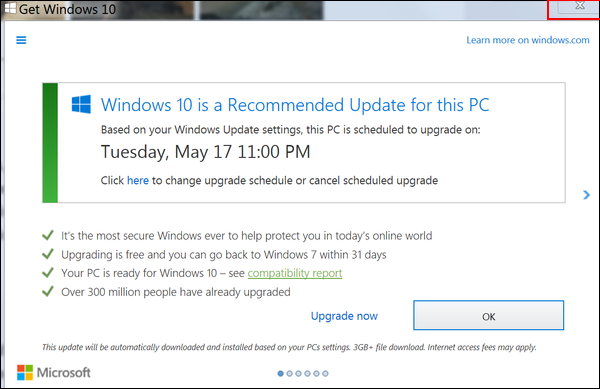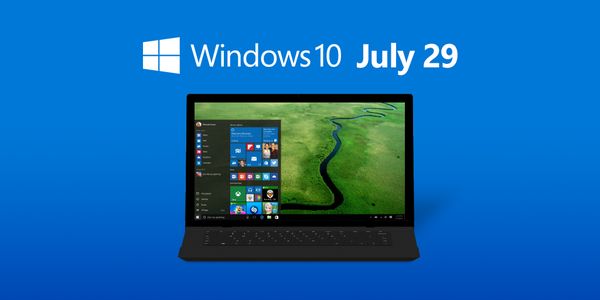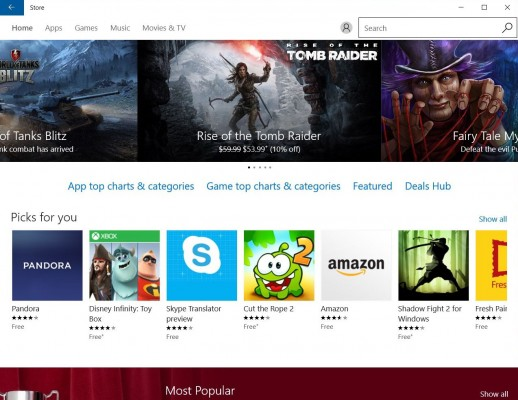5 Ways Microsoft Can Promote Windows 10 Without Fooling Users
Come on, Microsoft! There are so many great reasons for people to upgrade to Windows 10. But when the company resorts to deception and UI trickery in an effort to get users to install the new OS, it undermines all of its arguments. This week, several Windows 7 and 8 users noticed that, when they clicked the Close button on a Windows 10 upgrade alert, the new operating system installed anyway.
Microsoft considers the unwanted installations a "feature," not a bug, the company confirmed in a statement to Windows Expert Paul Thurrott this week. Closing the notification window only signifies to Microsoft that you want to hide the alert, not that you want to avoid the upgrade.
It's easy to understand why Microsoft is eager to get users onto Windows 10. The new flagship operating system does more than just provide new features and enhanced performance; it enables the current Windows Store and an ecosystem of "universal apps." The cut of revenue Microsoft gets from selling these mostly third-party apps to users could be huge. Apple's share of its App Store sales netted that company $6 billion in 2015 alone. Windows 10 also collects some valuable but anonymized data from users that Microsoft can use for advertisements.
Unfortunately, forcing an upgrade on unsuspecting users will not lead to a lot of Windows 10 fans. So here's my advice. These are five ways Microsoft should promote Windows 10, without fooling people.
1. Extend the July 29th free-upgrade deadline.
Microsoft recently reiterated that it plans to stop offering free Windows 10 upgrades after July 29, the operating system's one-year anniversary. After that date, Windows 7 and 8 users who want to install the upgrade will have to pay at least $119 (for Windows 10 Home).
This hard deadline for upgrading makes little sense. If you really want people to upgrade and they didn't do it for free in the first 12 months, why on earth would they pay $119 thereafter? Perhaps Microsoft believes that setting an end point and sticking with it will encourage procrastinators to take the leap, but what about those who don't?
A recent Computerworld article theorizes that Microsoft has to stick with its deadline because the free upgrades are suppressing PC sales from consumers who will now buy new computers with the OS preloaded. But again, if someone wouldn't upgrade their laptop to Windows 10 for free, why would they pay extra — in this case, more than a hundred dollars extra — just to get it? PC sales are shrinking for a lot of reasons, but a free Windows 10 upgrade isn't one of them.
Sign up to receive The Snapshot, a free special dispatch from Laptop Mag, in your inbox.
2. Lower manufacturer licensing fees across the board.
One reason for the decline in PC sales is the high cost of upgrade-worthy hardware. Nobody wants to buy a $500 laptop, because most of today's $500 laptops aren't significantly better than consumers' still-working models from 2011. Along with the cost of components such as the CPU and RAM, every PC vendor has to pay Microsoft licensing fees to install Windows on their computers. The amount that major manufacturers like Dell and Lenovo pay per license is a well-guarded secret, but it definitely adds to the overall price of their products.
A couple of years ago, Microsoft started offering manufacturers free Windows on the company's cheapest devices, in order to compete with Chromebooks. And, lo and behold, the sub-$300 laptop market is booming, with a growth rate of 19 percent year over year in the first quarter, according to NPD Group. However, to qualify for free Windows, laptops have to have the worst specs possible. The specs aren't public, but we've heard from reliable sources that devices don't qualify for free Windows if they have more than 2GB of RAM.
If Microsoft included more-robust laptops in its free Windows program and cut the licensing fees it charges manufacturers for other systems, the price of PCs would drop accordingly. Sales of Windows 10 computers would increase, and so would the user base of app-purchasing consumers.
3. Stop punishing system builders.
While we don't know what manufacturers like Dell pay to put Windows on their computers, we can imagine that it is far less than the $119 Microsoft charges consumers for Windows 10 Home.
So, if you buy a "bare-bones" computer, such as the Intel NUC, or you build your own PC from scratch, you need to add $119 to the cost. That's a huge disincentive for people to buy those products, and it further suppresses computer sales and the user base. If the company is willing to sell Acer a Windows 10 license for $50 (just throwing out a guess here), it should charge you the same amount when you buy a mini PC and have to install your own OS.
4. Offer Windows Store credit.
How about incentivizing users to upgrade, rather than trying to fool them? For some people, the increased performance and functionality of Windows 10 are good enough reasons to upgrade, but that's not the case for everyone. How about offering consumers $10 or $20 of credit to use for apps in the Windows store? That may sound like a huge and expensive giveaway, but it's also a great way to get consumers accustomed to buying apps in Windows 10, which is the ultimate reward for Microsoft.
5. Add killer first-party apps.
Like Microsoft's previous operating systems, Windows 10 comes with plenty of first-party apps preloaded, but unfortunately, those apps are not particularly compelling. The built-in email software pales in comparison to web-based tools such as Gmail, and the News (sports and finance) apps provide no real advantages over just visiting the Bing website or another news source.
Microsoft needs to take a page from Apple's book and include really strong built-in programs. It desperately needs a good Windows 10 video editor that's comparable to Apple's iMovie. (Windows Live Movie Maker is still available as a download, but it hasn't been updated in years.) It should provide a friendly backup tool that's on a par with Time Machine and a preloaded audio editor that's half as good as GarageBand. It would even help Microsoft's case if the company made the full version of Solitaire free, when now you have to pay to unlock all of its features.
Bottom Line
Yes, all of my proposals involve Microsoft giving up some money, either in terms of licensing fees, incentives or app development. However, if Microsoft really wants users to upgrade, it has to invest in its ecosystem for the long term.
In 2016, Microsoft is the only major software vendor that charges money for its operating system. Mac users get free upgrades to the latest version of OS X every year, while iPhone and iPad owners get the latest iOS without a fee. Google doesn't charge device makers a fee for Android or Chrome OS. Ubuntu and the other leading Linux systems have always been free. These other companies see the value of building their user bases over turning a direct profit on the OS.
Windows 10 is worth paying for, but if Microsoft wants to grow its ecosystem, get people to use its app store and encourage developers to build universal apps, it needs to give users more incentives to upgrade.
Top image credit: Shutterstock / Antonio Guillem
Windows 10 Basics
- 7 Settings to Change Right Away
- Windows 10 Keyboard Shortcuts to Save You Clicks
- 5 Ways to Take Screenshots
- Change Your Password in Windows 10
- Uninstall Programs in Windows 10
- Enable or Disable Tablet Mode
- Add a User (Child or Adult)
- Change the Screen Resolution
- Sync Your Settings Across Devices
- Sync iPhone with Windows 10
- Control Windows 10 with Your Voice
- Upgrade to Windows 10 From Windows 7 or 8
- Eliminate Blue Light With Night Light
- Create a New Folder
- Get to the Desktop in Windows 10
- Add a Printer
- All Windows 10 Tips
- Set Alarms






